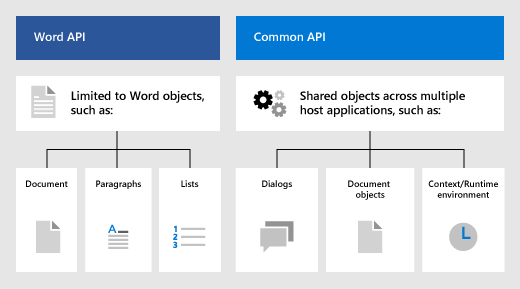Note
Access to this page requires authorization. You can try signing in or changing directories.
Access to this page requires authorization. You can try changing directories.
This article describes concepts that are fundamental to using the Word JavaScript API to build add-ins.
Office.js APIs for Word
A Word add-in interacts with objects in Word by using the Office JavaScript API. This includes two JavaScript object models:
Word JavaScript API: The Word JavaScript API provides strongly-typed objects that work with the document, ranges, tables, lists, formatting, and more. To learn about the asynchronous nature of the Word APIs and how they work with the document, see Using the application-specific API model.
Common APIs: The Common API give access to features such as UI, dialogs, and client settings that are common across multiple Office applications. To learn more about using the Common API, see Common JavaScript API object model.
While you'll likely use the Word JavaScript API to develop the majority of functionality in add-ins that target Word, you'll also use objects in the Common API. For example:
- Office.Context: The
Contextobject represents the runtime environment of the add-in and provides access to key objects of the API. It consists of document configuration details such ascontentLanguageandofficeThemeand also provides information about the add-in's runtime environment such ashostandplatform. Additionally, it provides therequirements.isSetSupported()method, which you can use to check whether a specified requirement set is supported by the Word application where the add-in is running. - Office.Document: The
Office.Documentobject provides thegetFileAsync()method, which you can use to download the Word file where the add-in is running. This is separate from the Word.Document object.

Word-specific object model
To understand the Word APIs, you must understand how key components of a document are related to one another.
- The document contains sections, pages, and document-level entities such as settings and custom XML parts.
- A section contains a body.
- A body has paragraphs, content controls, and range objects, among others.
- A range is a contiguous area of content, including text, whitespace, tables, and images. The Word.Range object contains most of the text manipulation methods.
- A list contains numbered or bulleted paragraphs.
- The document is contained in a window.
- A window has panes. A pane surrounds the visible area of the document.
For the full set of objects supported by the Word JavaScript API, see Word JavaScript API.
See also
Office Add-ins